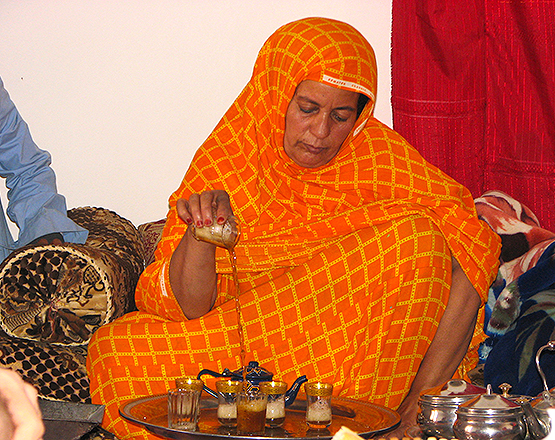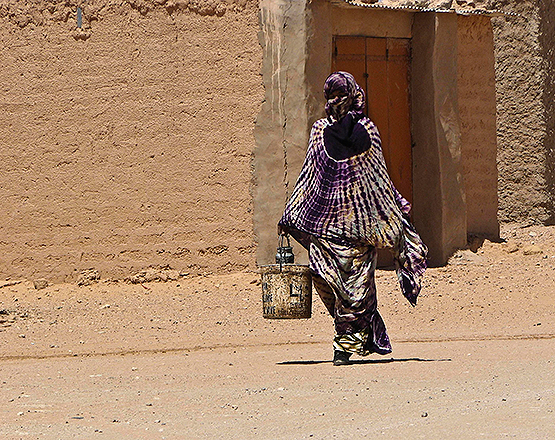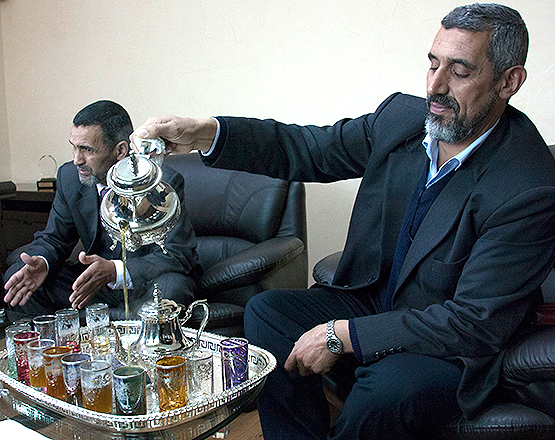Los saharauis no tienen casi nada. Expulsados por Marruecos, olvidados por España, viven en campos de refugiados en terreno argelino -la declarada República Árabe Saharaui Democrática, RASD- con pocas posibilidades de producir y con ninguna oportunidad para el desarrollo. Pero tienen algo que nadie les puede quitar.
Una tradición que conservan con el paso de los años: invitar a té cuando reciben visitas. Puede que no tengan agua, puede que no tengan luz o puede que ese día no sea posible comer cabra o camello, pero nunca les falta té para ofrecer. ¿Por qué? Porque el té es algo más que una simple bebida.
VIDA, AMOR Y MUERTE
Para los saharauis, ofrecer té es un gesto de generosidad y aceptarlo es de cortesía. Sentados sobre el suelo en círculo, en sus pequeñas casas de adobe, anfitriones y huéspedes disfrutan de conversaciones lentas aderezadas con sorbos de un té caliente que inexplicablemente quita la sed del desierto. Pero las visitas no sólo aceptan tomar un té, sino tres. Son tres los que deben tomarse durante la estancia en casa ajena, cada uno con un sabor ligeramente diferente. El primero es más amargo (tiene menos azúcar), el segundo más dulce y el tercero más ligero. Los tres tes tienen su explicación poética que los propios saharauis te explican: «El primero es amargo como la vida, el segundo es dulce como el amor y el tercero es suave como la muerte». Vida, amor y muerte. Por eso el té saharaui define tan bien la esencia de su pueblo.
Se trata de té verde importado de China, cuya originalidad radica en la forma en que lo preparan y sirven. Es toda una ceremonia en la que se deben cumplir los pasos para que el sabor del té sea el que caracteriza a este pueblo del desierto.
Echan agua en una tetera (berred) que calientan con brasas de carbón vegetal. En ella vierten medio vaso de té, aunque la primera ración será desechada por ser demasiado amarga. Vuelven a verter agua en la tetera con té y esta vez echan bastante azúcar. Cuando hierve, el té será escanciado en unos pequeños vasos (kisan). Desde el primer vaso se escanciará en el segundo y así, varias veces hasta conseguir la espuma deseada y el sabor idóneo. Su color dorado, su espuma blanca, su abrasante calor, sus virutas de hierbas al final del vaso, su dulzura extrema, su adicción, el té saharaui lo tiene todo para enamorarte del momento.
Sus vecinos de Marruecos también sienten una pasión por el té, en especial por el de menta, si bien su ceremonia de preparación no es tan romántica como la saharaui. También en las casas marroquíes el té es símbolo de hospitalidad, siempre acompañado de ricas pastas o dulces árabes. Servido generalmente en cuberterías más lujosas -plateadas- que las saharauis, la cortesía marroquí en torno al té es similar. Beber té en el Sáhara no es sólo disfrutar de una bebida dulce; es vivir un auténtico momento de placer que deseas que no termine nunca, ya sea en una casa de adobe en mitad del desierto saharaui, como al atardecer en una terraza de Jemaa el-Fnaa (Marrakesh) con los rezos de la mezquita de fondo.






1 Comentario